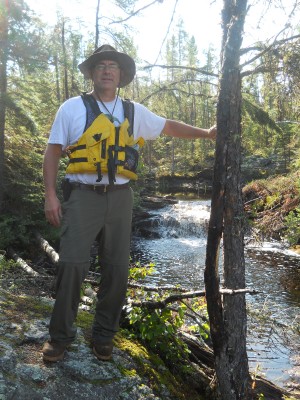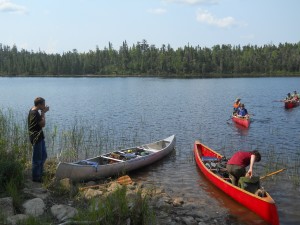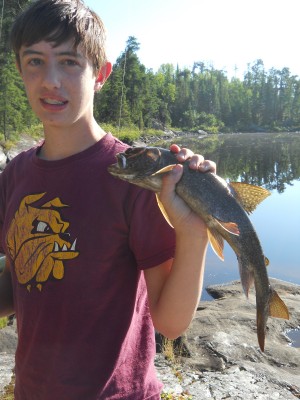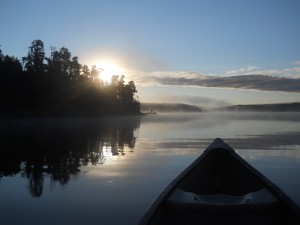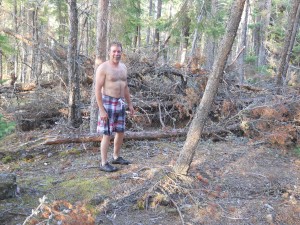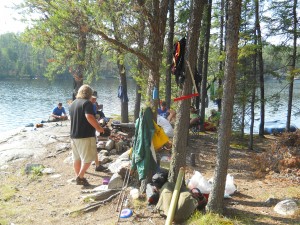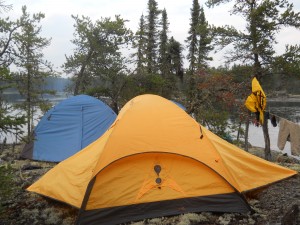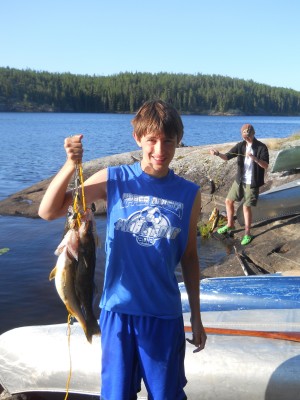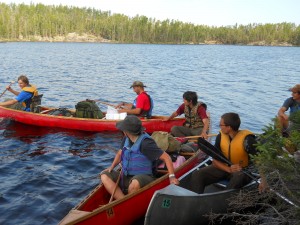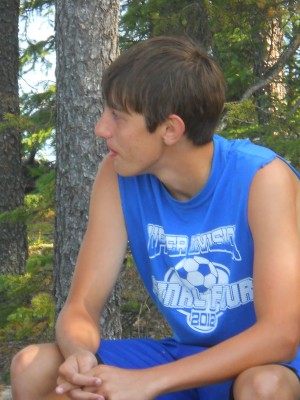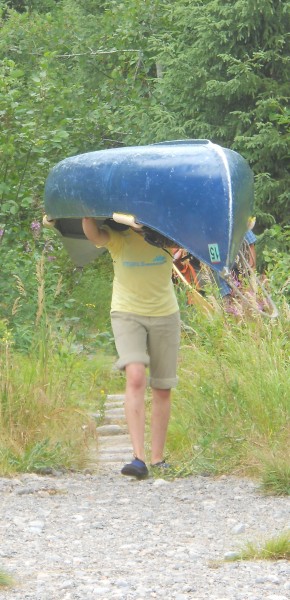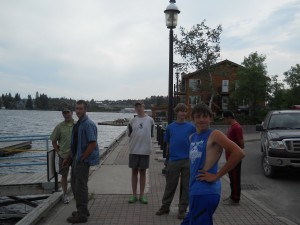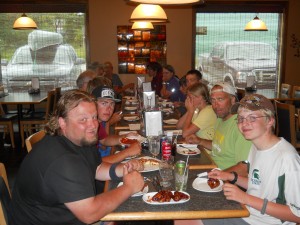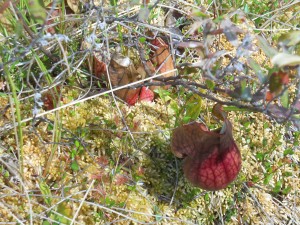800. Eighty-plus. Fifty-two. Sixteen. A dozen. Ten. Eight. Eight again. Six. Five. Two. Two more. Those are some of the numbers associated with last week’s trek into the hinter lands of the Ontario taiga. For you non-adventurous types, a definition is needed here:
taiga |ˈtīgə|
noun (often the taiga)
the sometimes swampy coniferous forest of high northern latitudes, esp. that between the tundra and steppes of Siberia and North America.
ORIGIN late 19th cent.: from Russian taĭga, from Mongolian.
(From The Apple Dictionary)
Having given you a short lesson in geography, let me explain the numbers. 800 is the longest “official” portage some members of Boy Scout Troop 106 of Hermantown, MN completed on our recent journey north to Woodland Caribou Provincial Park. I say “official” because one of the passages between two of the boreal lakes on our route marked as a shallow creek turned out to be virtually dry. Which necessitated nearly a mile of dragging canoes through saw grass, muck, Canadian Shield gray boulders and pink quartz. Understand; I didn’t go on this part of our collective journey but I sure heard about it from the six brave explorers who made the trek. More on that later.
Eighty-plus is the number of walleyes that my group, five pairs of canoeists, caught in two days of fishing on a lake which, because I’d like to go back and fish it again, shall remain nameless. Sixteen is the number of adults and young folks who made portions of the overall trip. I say portions because, as indicated, ten of us stayed on the fishing lake while six intrepid explorers made a large loop totaling over fifty miles of canoeing and portaging from start to finish. The explorers caught few fish but saw a bull moose resplendent in lily pads, water dripping off its rack as if staged for a Molson commercial. The six explorers also viewed pictographs drawn by long-forgotten First Peoples and touched the edge of true taiga where the spindly white spruce and jack pine that cover this part of the Canadian Shield give way to a virtually treeless landscape. And the explorers crossed over an old burn where the spindly conifers were charred to charcoal. Within the burn, Julie Belden, the only adult woman on the trip, found wild blueberries ripe and ready for the picking.
Another digression. The number two is significant here for two reasons (cute, eh?): There were two females on the journey, including Julie and Heidi Hummell a teenager who defied the pouting, complaining version of young women seen on television sitcoms. Julie went with the explorers while Heidi and her father stayed with the fishing group.Two females. Two groups.
Ten? That was the most portages done by the explorers group led by Jim Belden in one day. Eight? That’s the most portages completed by the fishing group led by Bryan Von Arb in one day. Eight was also supposed to be the number of fishermen staying behind to catch walleye on the secret lake I told you about but Mark and Heidi Hummell decided they’d rather catch walleye than wade loon shit. Go figure. So the second number eight in my computation became ten. A dozen represents my approximation of the snaky, voraciously hungry northern pike the group landed over the six days we were in Woodland Caribou. Since we were after walleye and lake trout, I don’t think anyone minded that we tossed every pike back into the tannin stained water of the park. Five represents the number of lake trout the group caught, beginning with my son Jack’s very first laker.
For those of you who are thinking, A week on the water in a park akin to the BWCA isn’t so tough, let me explain some facts about Woodland Caribou Provincial Park. First, the name. Yes, there are actual caribou in the park. We didn’t see any, not even the group that went further north. But, as indicated, the explorers did see a resplendent bull moose up close and personal and, the following scene will flesh out what the fishing crew experienced.
Morning. Before breakfast. The mist is clearing off Secret Lake.
I am sitting on the rock outcropping a few meters from our campsite, sipping hot morning coffee and marveling at my good fortune. Good fortune because I was able to convince my fifteen-year old son that this would be an unforgettable trip. Good fortune because, with the guiding abilities of Mr. Von Arb, we’ve found walleye. Good fortune because I am married to a beautiful and gracious woman who knows that, from time to time, I need to replenish my internal battery on wilderness.
Anyway, on Secret Lake there had been another group camping on a spit of rock a mile or so away. That group left with the onset of the sun. The lake is calm. There is no wind. And yet, as would hold true throughout the week, there are no bugs. No gnats. No accursed black flies. No mosquitoes. So I am sitting on granite, looking out over a quiet body of black water, listening to the cry of loons in the distance, when I see them.
At first, I’m not sure that what I am seeing are caribou. This is because the animals aren’t prancing along distant shoreline. They are swimming, making a beeline from the campsite the folks have just left for the far shore.
“Caribou!” I shout.
Nick Mallett, one of the Scouts, emerges from the trees.
“Where?”
“There, near the point. They’re swimming.”
“My dad has binoculars.”
“Get them. And tell the others.”
Very soon, Nick returns with the eight others in our party. We all stand on the stoney shoulders of the Shield, in a ragged line of expectancy, watching the animals swim. Each of us takes a turn with the field glasses. I’m last in line. I have the benefit of watching the animals emerge from the water onto solid ground at the mouth of a tiny creek Jack and I had fished the day before.
“They’re not caribou,” I finally say when I see the distinctive lanky legs and snout of North America’s largest ungulate. “It’s a cow moose and twin calves.”
So yes, if one counts moose as a commonality between Woodland Caribou and the BWCA, together with the omnipresent granite, thin soil, and coniferous forest, there are similarities between the provincial park and America’s most beloved canoeing retreat. But that’s about where the connections between the two places end.
First, the portages. The BWCA may have removed the wonderfully helpful portage signs (marked in rods) that announced each trail, along with the convenient portage rests on longer overland treks. But the portages one carries his or her canoe across in the BWCA (even the remotest of the remote) are generally maintained. Not so with even the most well used portages in Woodland Caribou. The trails are rugged, narrow, prone to have jack pine or white spruce blow downs blocking them, and are generally unmarked. You have to be a woodland detective to find the trail from one lake to the next.
Then there is the traffic. The two parks are about the same size. Woodland Caribou is 1.2 million acres of prime wilderness. The BWCA (without the adjacent Quetico across the border) is 1 million acres, give or take. But whereas the BWCA sees 200,000 visitors a year, Woodland Caribou has less than 1,000 visitors a season. That’s right. Less than 1,000. So while you may see fellow campers and canoeists on lakes that are known for their walleye fisheries (as our fishing group did), the more intrepid paddlers, like our explorers group, can pretty well be assured of seeing no other humans.
Then there are the campsites. On occasion, after massive straight line winds or fires, campsites in the BWCA become unusable. But the beaveresque crews of the US Forest Service usually have them cleared and in fine shape before too long. And all the approved campsites in the BWCA have fire grates and latrines, making camping, while certainly more primitive than your typical state park, doable for even the sissy pants in your group. Caribou has no fire grates. No latrines. And most of the campsites are prone to being rendered unusable without the aid of a hatchet and saw. Here’s what I mean.
Notice how few of the standing trees in the photo are actually vertical? Every night, the creaking of white spruce and jack pines ready to tumble to the ground made for some interesting sleep given that our thinly skinned tents provided little shelter against the sudden descent of trees. This isn’t to say that some of the sites weren’t as picturesque or more so than their American counterparts.
As the photo to the left depicts, our tenting spot on the crown of a rocky shoulder on Jake Lake was everything you’d want in a campsite: A clearing in the trees to let the breeze waft through. Plenty of firewood. Spots to use for your daily deposits (remember, there are no latrines and you really can’t dig into rock!). Fish (Jack caught a nice three pound laker we baked for breakfast on Jake). And even a sandy beach to clean off the dust and grime of the trail.
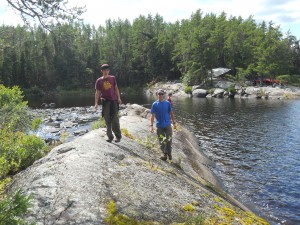
Zac Von Ab and Jack Munger, Secret Lake Falls. Note the campsite directly behind them where you can listen to the music of the falls entering the lake.
As depicted in the above photo, Secret Lake boasted not one, not two, but three BWCA-quality sites, two of which the separate squadrons of our group inhabited before splitting into the adventurers and the fishermen (and woman, sorry Heidi-you did your part too!). But then there were times when, as shown in the previous snapshot of Mr. Von Arb on Bunny Lake, or earlier in the trip, on East Lunch Lake, where the campsites designated on the map either didn’t exist or had been obliterated by storms.
Our first night, which we spent on East Lunch Lake, was essentially an experience in sleeping on bedrock.
Thank God for the weather. Other than a rainstorm our first day on the water, which repeated itself as we slept on the rocky outcropping on East Lunch, we never encountered rain, or even wind until our time was done and we were back on Leano Lake searching for the invisible portage to the parking lot. Every day was sunny, warm, pleasant, and, though it’s repetitive to say so, bugless.
After being separated from the adventurers for two days, the fishermen reunited with the vision questers to paddle out as a group.
On the way to Leano Lake, I marveled at how tan and strong my adolescent son had become in one short week. Not that everything was always perfect in our canoe. Oh no, that would be a lie. We had our moments, like when Jack was grousing that I wasn’t paddling in the stern while he was trying to fish. He was frustrated, I think, because everyone else seemed to be catching walleye but us. His tone hinted disrespect. I splashed water at him with my paddle. We were in danger of getting into a row in the middle of the lake where everyone in the fishing group would have a ring side seat. But then, a walleye hit Jack’s jig. He set the hook like a pro. We began to catch fish and the storm passed. Funny how northerly bred walleyes, which fight so much deeper and stronger than their warm water cousins, can change a kid’s perspective on life.
Once the two groups made the parking lot at Leano Lake, all that was left to do was secure our gear, tie down the canoes on the four vehicles in our caravan, and make the long, dusty trek back to Red Lake where pizza awaited.
Rumors of a Pizza Hut proved false. But we lucked out. Antonio’s, it turns out, a place that, from the outside, looks like a hole in the wall, but on the inside, rivals the finest Olive Garden, had big pizzas, hand-made, cooked to perfection, and at a price far less than one would pay at a chain. It seems Troop 106’s good fortune held even in town.
Then it was off to Pakwash Provinicial Park for our last night of camping before the eight hour drive home. Pakwash is akin to the Minnesota state parks you may be familiar with. It has spots for tenters (like us) and RVs, pop-up campers, and everything in-between all snugged along the shoreline of beautiful Pakwash Lake. I put on my swimming suit, gathered up my toothpaste and soap, and headed for the sand beach, foregoing the hot showers that Jack and everyone else went off to enjoy. I think I chose the lake over the showers because, well, I just didn’t want the magic of the trip to end. After scrubbing my near-naked body with a bar of Dove and cleaning a week’s worth of gunk from my gums over a cold water tap, I wandered down a gravel lane to the beach. The shoreline was deserted. Alone, my aching back, hips, knees, and shoulders finally at ease, I waded into Pakwash and let the cold waters of Northwestern Ontario surround me. Threatening skies sped to the east after lobbing a few splats of rain on my newly muscled shoulders and arms. There would be no rain to ruin the evening.
Peace.
Mark
A special thanks to Jim Belden, former Scoutmaster of Troop 106 for all his work in making this indeed a trip of a lifetime.

